Farin G. Curves and Surfaces for CAGD. A Practical Guide
Подождите немного. Документ загружается.


332 Chapter 17 Bezier Triangles
tri_decas(bpts, tri_num, ndeg, u, b, patch_pt )
/*
Function: Triangular
de
Casteljau algorithm for
an
n^th
degree triangular Bezier patch.
Algorithm
is
applied once for
a
given (u,v,w) and works
on
one
coordinate only.
Input: bpts[i] Bezier points (of one coordinate)
as
a
linear array (see
below).
i=0...tri_num
tri_num Based
on
the degree
of
the patch.
(n+l)(n+2)/2
ndeg Degree (n)
of
the patch.
u[i] Barycentric coordinates (u,v,w)
of
evaluation point. i=0,2
b[i]
A
working array with dimension
>=
to
bpts[].
Output: patch_pt One coordinate
of
the point
on
the patch evaluated
at
(u,v,w).
b []
Contents have been changed.
Linear array structure:
It
is
assumed that the usual (i,k,j) structure
of the Bezier net has been put into
a
linear
array
in
the following manner.
(E.g., for n=3)
b_(300)
">
bpts[0] (u=l)
b_(030) --> bpts[6] (v=l)
b_(003)
->
bpts[9] (w=l)
17.12
Problems
1 Find the barycentric coordinates of the incenter of a triangle.
'
2 Work out exactly how terms involving B|^(d) generalize the univariate
difference operator.
3 Show^ that the Bernstein polynomials B^(u) are linearly independent.
4 What is the geometric interpretation of the quadratic blossom b[ui,
U2]?
Of
the cubic blossom b[ui,
U2,
U3]?
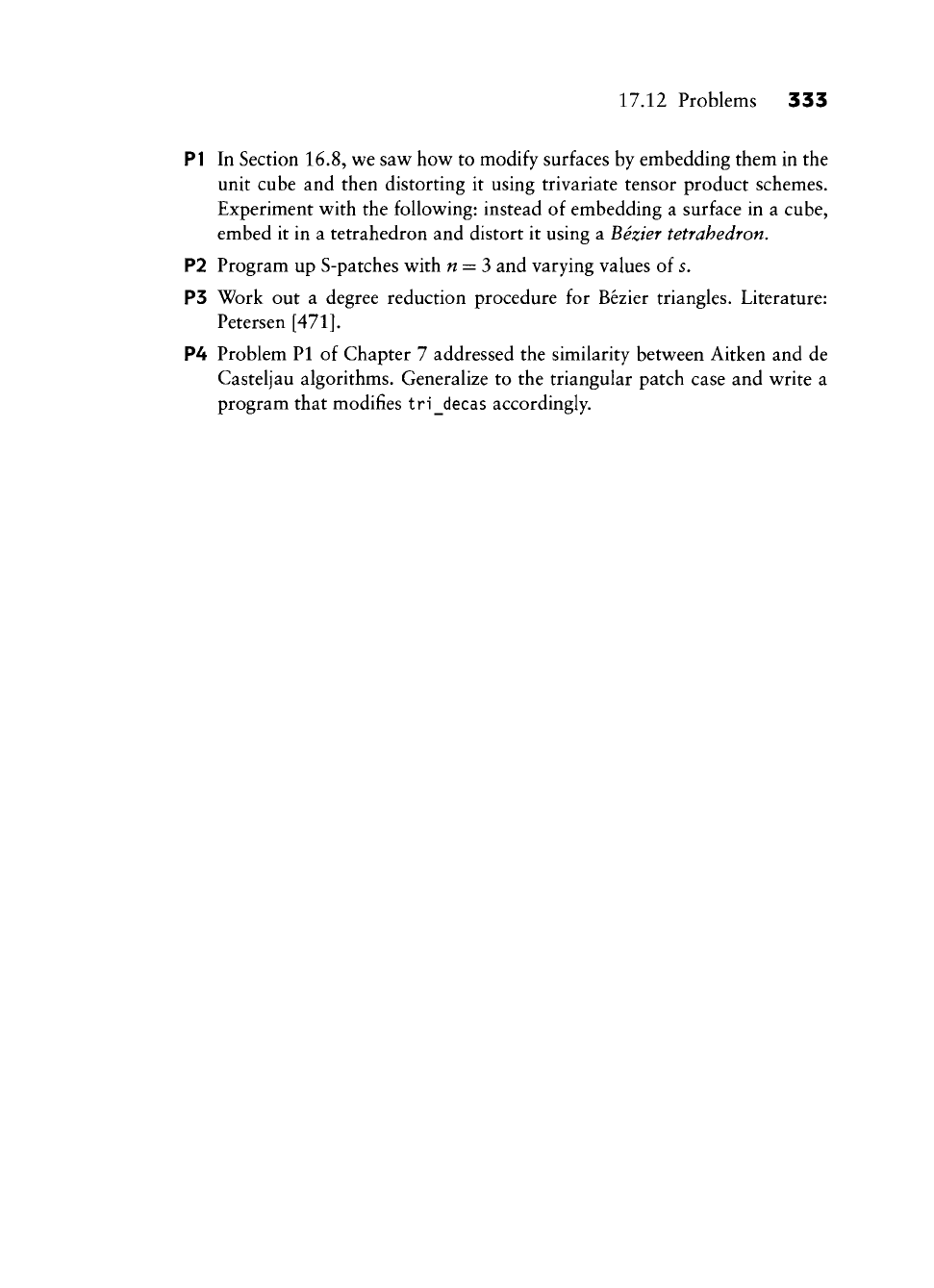
17.12 Problems 333
PI In Section 16.8, we saw how to modify surfaces by embedding them in the
unit cube and then distorting it using trivariate tensor product schemes.
Experiment with the following: instead of embedding a surface in a cube,
embed it in a tetrahedron and distort it using a Bezier tetrahedron,
P2 Program up S-patches with n = 3 and varying values of s.
P3 Work out a degree reduction procedure for Bezier triangles. Literature:
Petersen
[471].
P4 Problem PI of Chapter 7 addressed the similarity between Aitken and de
Casteljau algorithms. Generalize to the triangular patch case and write a
program that modifies tri_decas accordingly.

This Page Intentionally Left Blank
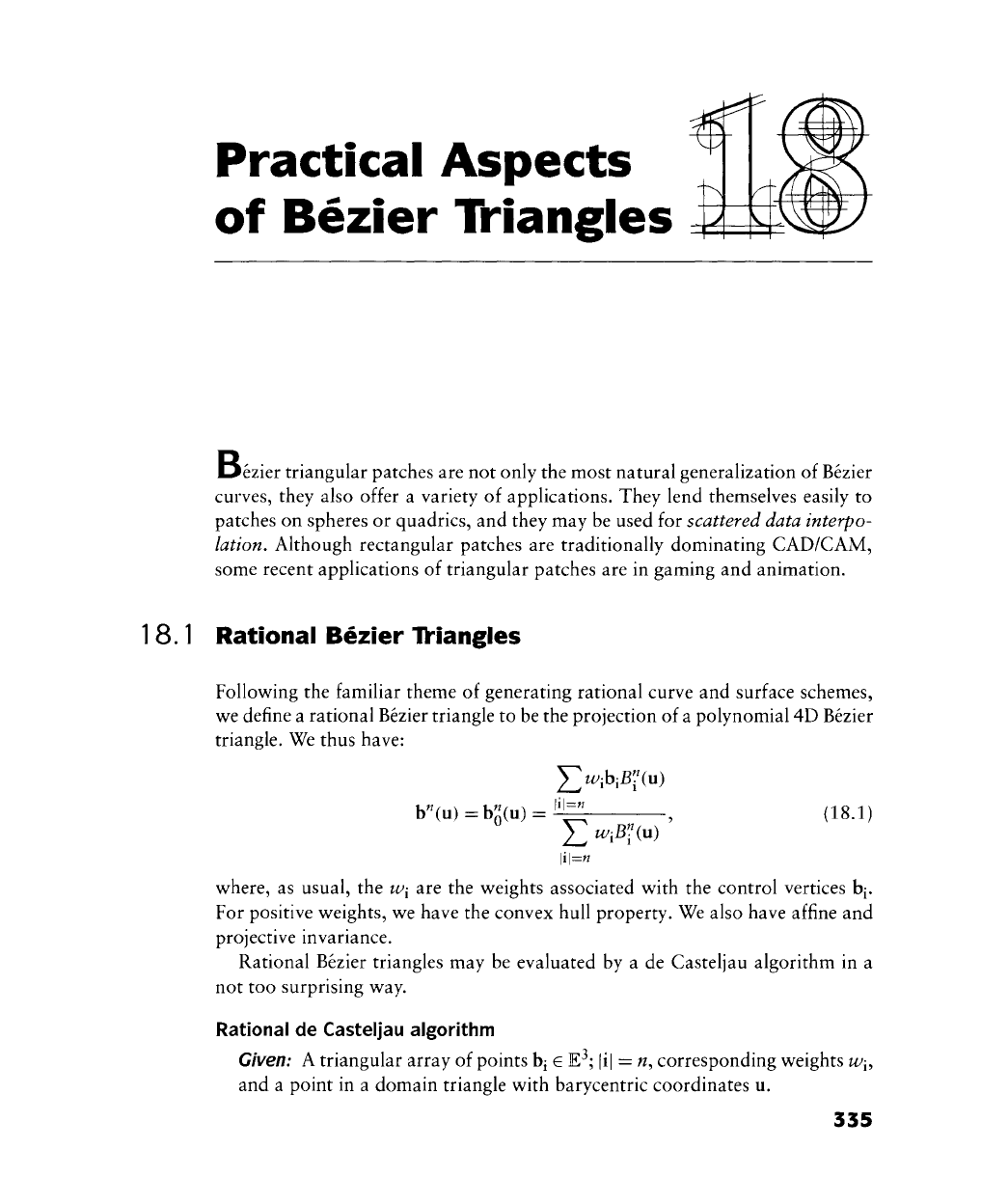
Practical Aspects
of Bezier Triangles
Dezier triangular patches are not only the most natural generalization of Bezier
curves, they also offer a variety of applications. They lend themselves easily to
patches on spheres or quadrics, and they may be used for scattered data interpo-
lation. Although rectangular patches are traditionally dominating CAD/CAM,
some recent applications of triangular patches are in gaming and animation.
18.1 Rational Bezier TV'iangles
Following the familiar theme of generating rational curve and surface schemes,
we define a rational Bezier triangle to be the projection of a polynomial 4D Bezier
triangle. We thus have:
^t^ibi^fCu)
b»=b»:
\x\=n
(18.1)
where, as usual, the
W[
are the weights associated with the control vertices h[.
For positive weights, we have the convex hull property. We also have affine and
projective invariance.
Rational Bezier triangles may be evaluated by a de Casteljau algorithm in a
not too surprising way.
Rational de Casteljau algorithm
Given: A triangular array of points
b^
G
E^;
|i| =
W,
corresponding weights
^j,
and a point in a domain triangle with barycentric coordinates u.
335
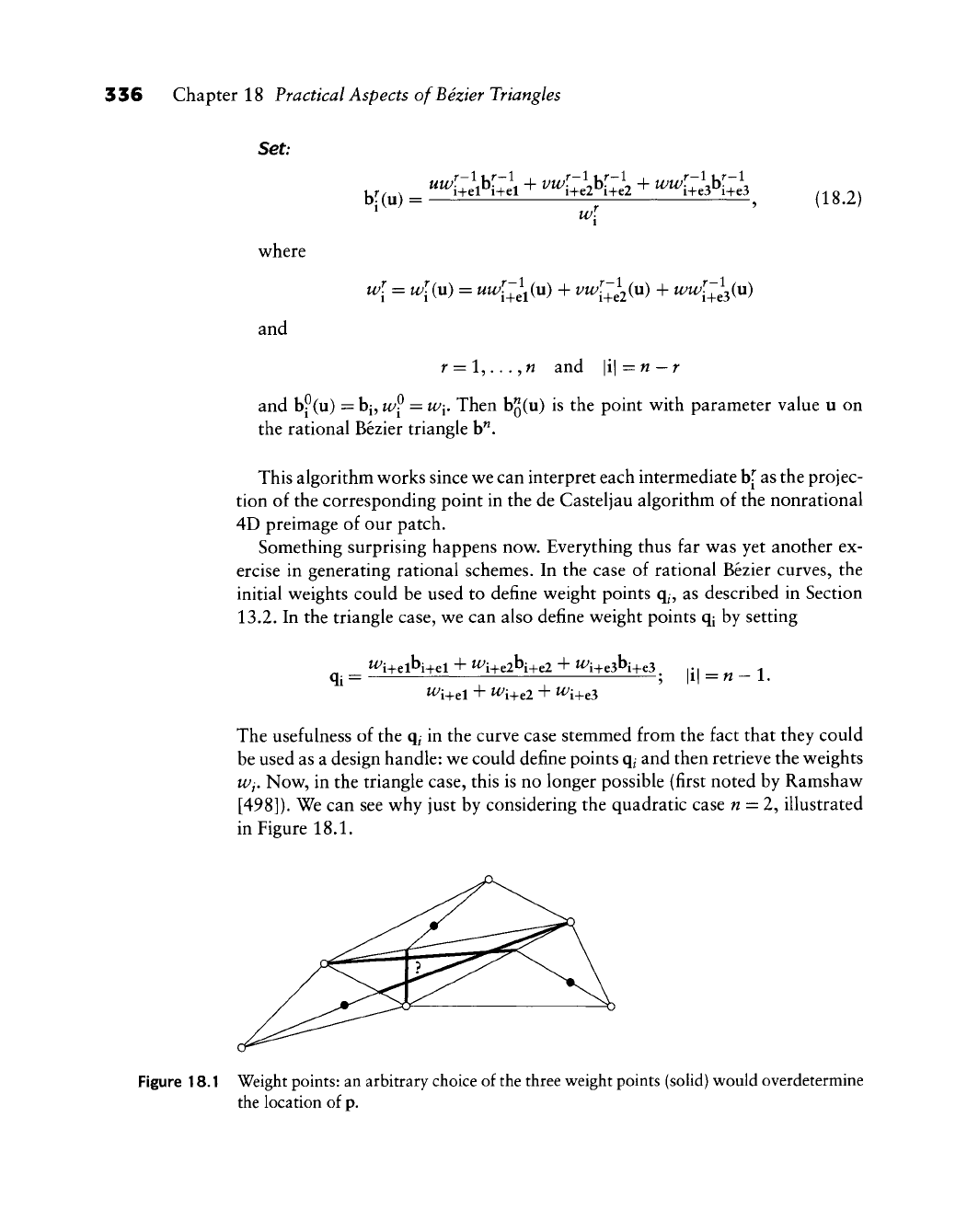
336 Chapter 18 Practical Aspects ofBezier Triangles
Set:
br(u):
(18.2)
where
and
r-l
./-I,
wl = wl(u) = uwl^^^iu) +
vw[_^^2^\x)
+ ww\^^^{\x)
r = !,...,« and \\\ = n
—
r
and b?(u) = bj, w^ =
W[,
Then bgCu) is the point with parameter value u on
the rational Bezier triangle b".
This algorithm works since we can interpret each intermediate b[ as the projec-
tion of the corresponding point in the de Casteljau algorithm of the nonrational
4D preimage of our patch.
Something surprising happens now. Everything thus far was yet another ex-
ercise in generating rational schemes. In the case of rational Bezier curves, the
initial weights could be used to define weight points q^ as described in Section
13.2.
In the triangle case, we can also define weight points qi by setting
qi =
^i+el + ^i+e2 + ^i+e3
\i\
= n-l.
The usefulness of the q^ in the curve case stemmed from the fact that they could
be used as a design handle: we could define points
q^
and then retrieve the weights
Wj. Now, in the triangle case, this is no longer possible (first noted by Ramshaw
[498]).
We can see why just by considering the quadratic case
w
= 2, illustrated
in Figure 18.1.
Figure 18.1 Weight
points:
an arbitrary choice of the three weight points (solid) would overdetermine
the location of p.
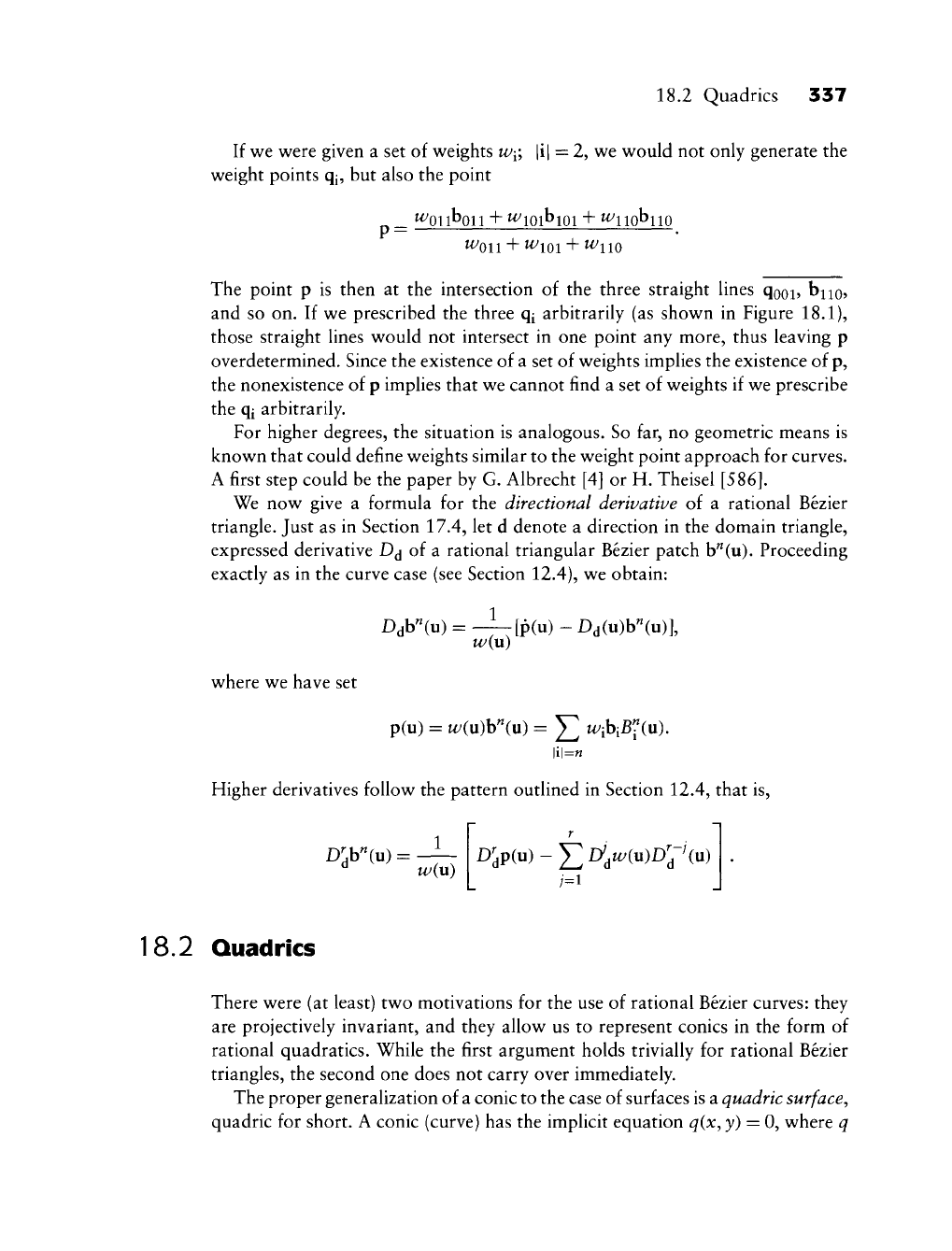
18.2 Quadrics 357
If we were given a set of weights
w^;
|i| = 2, we would not only generate the
weight points qj, but also the point
^011^011 + ^loibioi + ^iipbiio
^011+ ^101+ "^110
The point p is then at the intersection of the three straight lines qooi, b^o?
and so on. If we prescribed the three q^ arbitrarily (as shown in Figure 18.1),
those straight lines would not intersect in one point any more, thus leaving p
over determined. Since the existence of a set of weights implies the existence of p,
the nonexistence of p implies that we cannot find a set of weights if we prescribe
the qi arbitrarily.
For higher degrees, the situation is analogous. So far, no geometric means is
known that could define weights similar to the weight point approach for curves.
A first step could be the paper by G. Albrecht [4] or H. Theisel
[586].
We now give a formula for the directional derivative of a rational Bezier
triangle. Just as in Section 17.4, let d denote a direction in the domain triangle,
expressed derivative D^ of a rational triangular Bezier patch b"(u). Proceeding
exactly as in the curve case (see Section 12.4), we obtain:
Dab^u) = -^[p(u) - Dd(u)b"(u)],
wyxx)
where we have set
p(u) = w{\xW{\x) = J2 ^ibiBf
(u).
\i\=n
Higher derivatives follow the pattern outlined in Section 12.4, that is.
D:.b"(u)= ^
w(u)
18.2 Quadrics
There were (at least) two motivations for the use of rational Bezier curves: they
are protectively invariant, and they allow us to represent conies in the form of
rational quadratics. While the first argument holds trivially for rational Bezier
triangles, the second one does not carry over immediately.
The proper generalization of a conic to the case of surfaces is a quadric
surface^
quadric for short. A conic (curve) has the implicit equation q{x^ y) = 0, where q
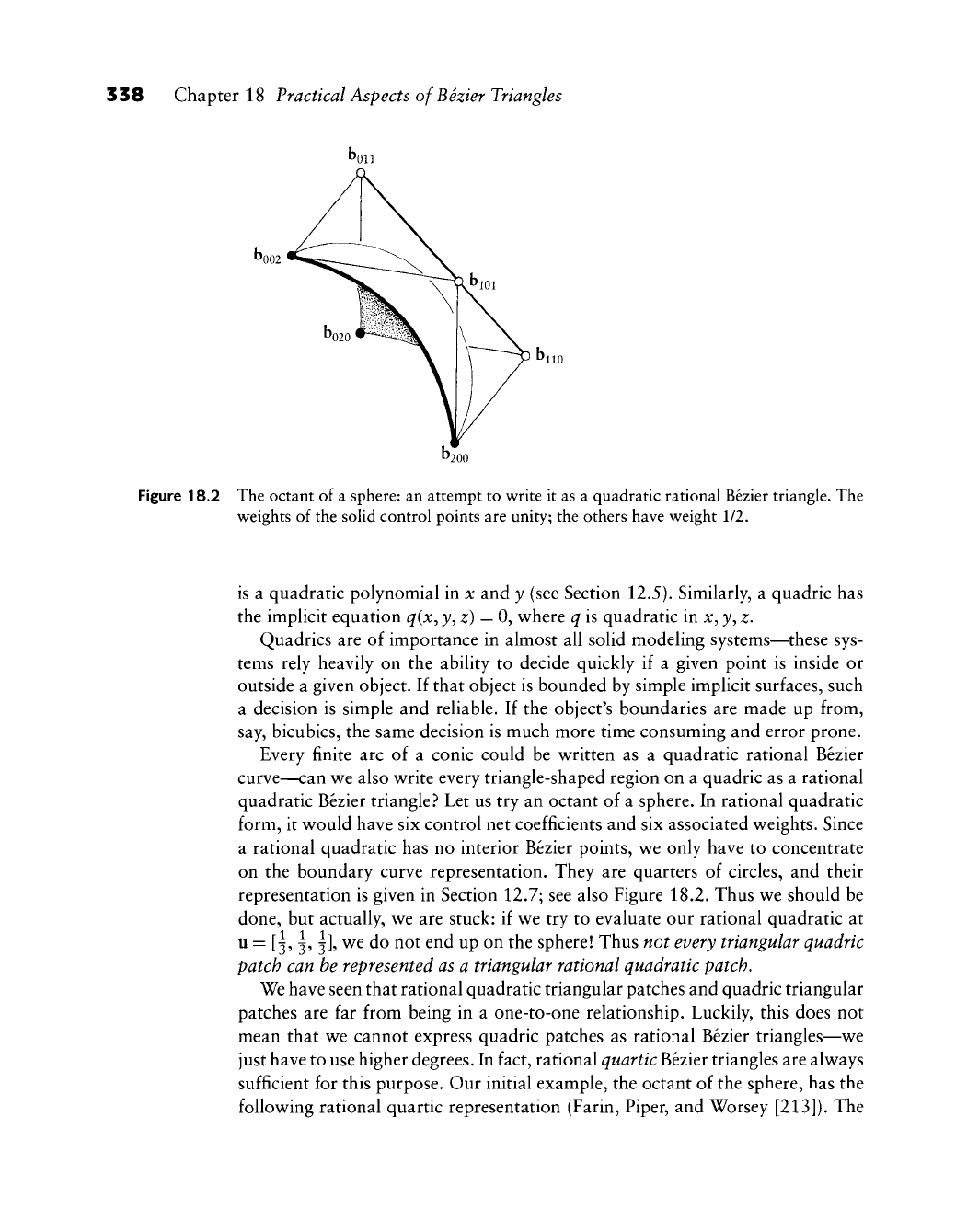
338 Chapter 18 Practical Aspects ofBezier Triangles
Figure 18.2 The octant of a sphere: an attempt to write it as a quadratic rational Bezier triangle. The
weights of the solid control points are unity; the others have weight 1/2.
is a quadratic polynomial in x and y (see Section 12.5). Similarly, a quadric has
the implicit equation q{x^ y, z) = 0, where q is quadratic in x^ y, z.
Quadrics are of importance in almost all solid modeling systems—these sys-
tems rely heavily on the ability to decide quickly if a given point is inside or
outside a given object. If that object is bounded by simple implicit surfaces, such
a decision is simple and reliable. If the object's boundaries are made up from,
say, bicubics, the same decision is much more time consuming and error prone.
Every finite arc of a conic could be w^ritten as a quadratic rational Bezier
curve—can v^e also write every triangle-shaped region on a quadric as a rational
quadratic Bezier triangle.'^ Let us try an octant of a sphere. In rational quadratic
form, it would have six control net coefficients and six associated weights. Since
a rational quadratic has no interior Bezier points, we only have to concentrate
on the boundary curve representation. They are quarters of circles, and their
representation is given in Section 12.7; see also Figure 18.2. Thus we should be
done, but actually, we are stuck: if we try to evaluate our rational quadratic at
u = [^, ^,
^],
we do not end up on the sphere! Thus not every triangular quadric
patch can be represented as a triangular rational quadratic patch.
We have seen that rational quadratic triangular patches and quadric triangular
patches are far from being in a one-to-one relationship. Luckily, this does not
mean that we cannot express quadric patches as rational Bezier triangles—we
just have to use higher degrees. In fact, rational quartic Bezier triangles are always
sufficient for this purpose. Our initial example, the octant of the sphere, has the
following rational quartic representation (Farin, Piper, and Worsey [213]). The
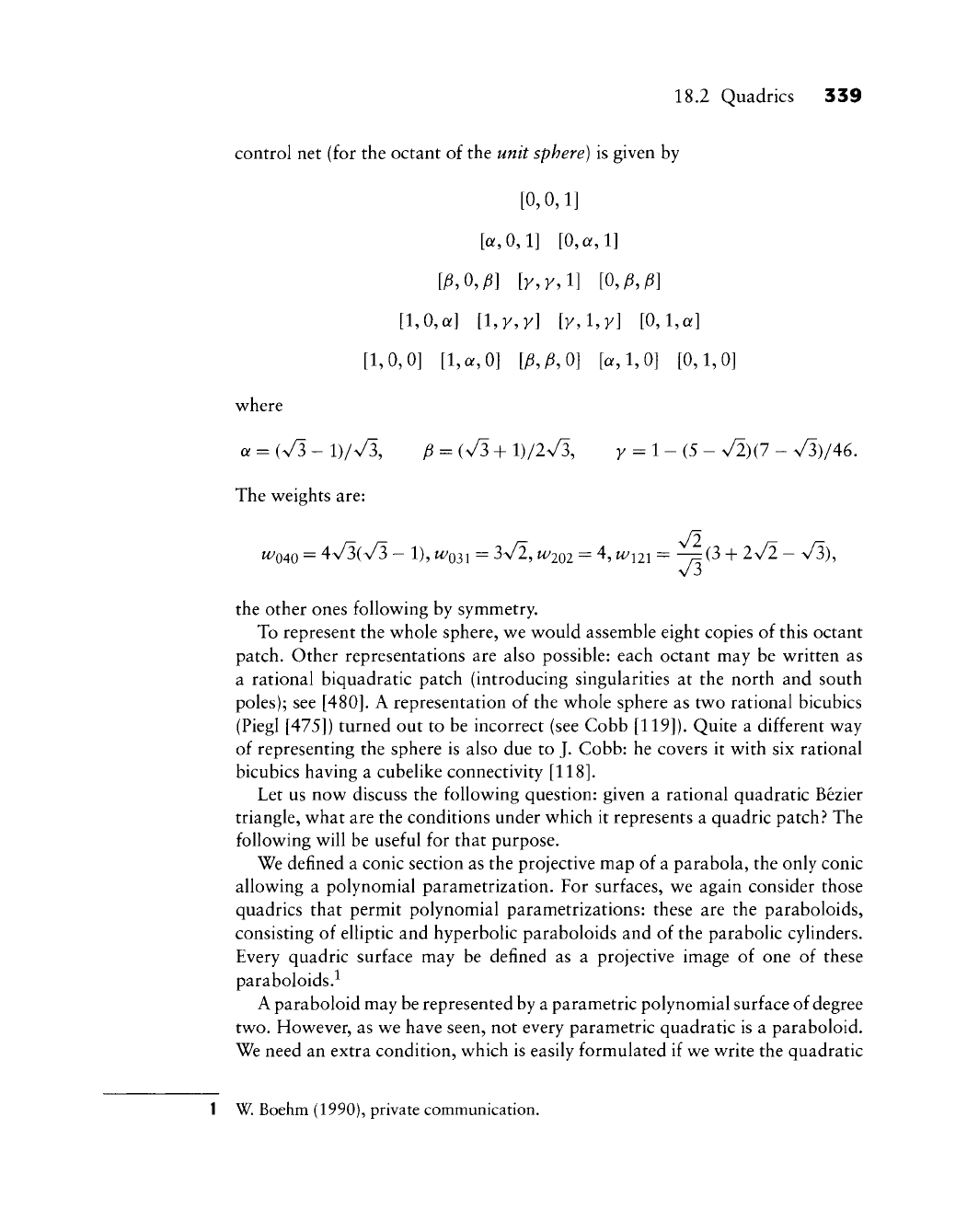
18.2 Quadrics 339
control net (for the octant of the unit sphere) is given by
[0,0,1]
[a, 0,1] [0,a,l]
[;6,0,y6]
[K,y,l] [0,/J,^]
[l,0,a] [l,K,y] [y,Uy] [0,l,«]
[1,0,0] [l,a,0] [p,p,0] [a, 1,0] [0,1,0]
where
ot
= {V3-
1)/V3,
^ = (V3 + 1)/2V3, y = 1 - (5 -
A/2)(7
- ^/3)/46.
The weights are:
u/040 = 4V3(V3 - 1), ^031 = 3^2, w/202 = 4, ^121 = -^(3 + 2V2 - VS),
the other ones following by symmetry.
To represent the whole sphere, we would assemble eight copies of this octant
patch. Other representations are also possible: each octant may be written as
a rational biquadratic patch (introducing singularities at the north and south
poles);
see
[480].
A representation of the whole sphere as two rational bicubics
(Piegl [475]) turned out to be incorrect (see Cobb [119]). Quite a different way
of representing the sphere is also due to J. Cobb: he covers it with six rational
bicubics having a cubelike connectivity
[118].
Let us now discuss the following question: given a rational quadratic Bezier
triangle, what are the conditions under which it represents a quadric patch.^ The
following will be useful for that purpose.
We defined a conic section as the projective map of a parabola, the only conic
allowing a polynomial parametrization. For surfaces, we again consider those
quadrics that permit polynomial parametrizations: these are the paraboloids,
consisting of elliptic and hyperbolic paraboloids and of the parabolic cylinders.
Every quadric surface may be defined as a projective image of one of these
paraboloids.^
A paraboloid may be represented by a parametric polynomial surface of degree
two.
However, as we have seen, not every parametric quadratic is a paraboloid.
We need an extra condition, which is easily formulated if we write the quadratic
1 W. Boehm (1990), private communication.
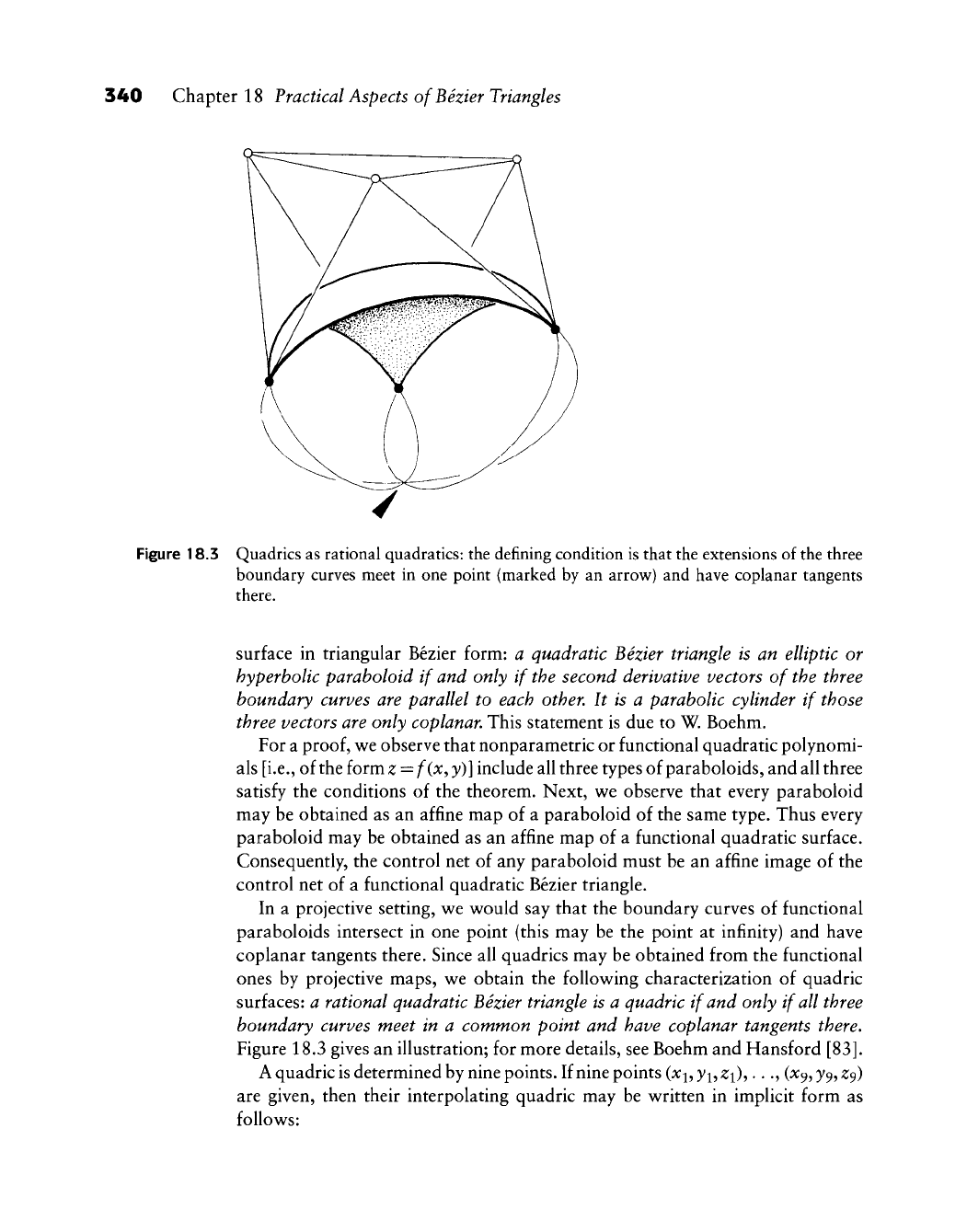
540 Chapter 18 Practical Aspects ofBezier Triangles
Figure 18.3 Quadrics as rational quadratics: the defining condition is that the extensions of the three
boundary curves meet in one point (marked by an arrow) and have coplanar tangents
there.
surface in triangular Bezier form: a quadratic Bezier triangle is an elliptic or
hyperbolic paraboloid if and only if the second derivative vectors of the three
boundary curves are parallel to each other. It is a parabolic cylinder if those
three vectors are only coplanar. This statement is due to W. Boehm.
For a
proof,
v^e observe that nonparametric or functional quadratic polynomi-
als [i.e., of the form z = f(x^ y)] include all three types of paraboloids, and all three
satisfy the conditions of the theorem. Next, we observe that every paraboloid
may be obtained as an affine map of a paraboloid of the same type. Thus every
paraboloid may be obtained as an affine map of a functional quadratic surface.
Consequently, the control net of any paraboloid must be an affine image of the
control net of a functional quadratic Bezier triangle.
In a projective setting, v^e w^ould say that the boundary curves of functional
paraboloids intersect in one point (this may be the point at infinity) and have
coplanar tangents there. Since all quadrics may be obtained from the functional
ones by projective maps, wt obtain the following characterization of quadric
surfaces: a rational quadratic Bezier triangle is a quadric if and only if all three
boundary curves meet in a common point and have coplanar tangents there.
Figure 18.3 gives an illustration; for more details, see Boehm and Hansford [83].
A quadric is determined by nine points. If nine points
(x^,
y^,
;^i),...,
(X9,
^9,
z^
are given, then their interpolating quadric may be w^ritten in implicit form as
foUovvrs:
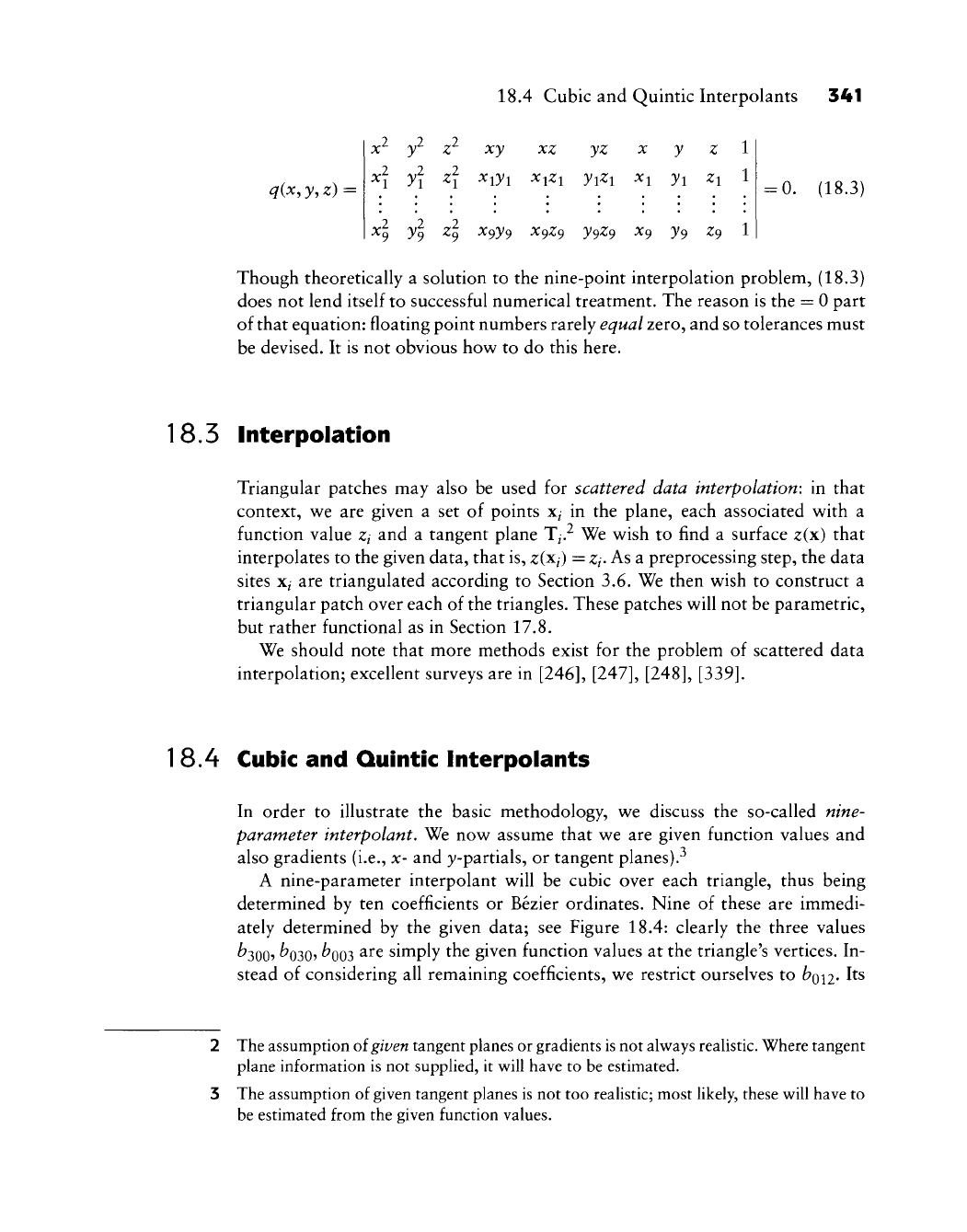
18.4 Cubic and Quintic Interpolants 341
q(x, y, z) =
111
x^
y^ z
xy
xz
yz
q yj H ^i>'i ^1^1 >'i^i ^1 >'i ^1
<\ y\ zj x^y^ x^Z9 y^z^ x^ y^ z^ 1
:0.
(18.3)
Though theoretically a solution to the nine-point interpolation problem, (18.3)
does not lend itself to successful numerical treatment. The reason is the = 0 part
of that equation: floating point numbers rarely equal zero, and so tolerances must
be devised. It is not obvious how to do this here.
18.5 Interpolation
Triangular patches may also be used for scattered data interpolation: in that
context, we are given a set of points x^ in the plane, each associated with a
function value Zj and a tangent plane Tj? We wish to find a surface ^(x) that
interpolates to the given data, that is, zixj) =
Zj.
As a preprocessing step, the data
sites Xj are triangulated according to Section 3.6. We then wish to construct a
triangular patch over each of the triangles. These patches will not be parametric,
but rather functional as in Section 17.8.
We should note that more methods exist for the problem of scattered data
interpolation; excellent surveys are in
[246], [247], [248], [339].
1
8.4 Cubic and Quintic Interpolants
In order to illustrate the basic methodology, we discuss the so-called nine-
parameter interpolant. We now assume that we are given function values and
also gradients (i.e., x- and y-partials, or tangent planes).^
A nine-parameter interpolant will be cubic over each triangle, thus being
determined by ten coefficients or Bezier ordinates. Nine of these are immedi-
ately determined by the given data; see Figure 18.4: clearly the three values
^300? ^030? ^003 ^^^ simply the given function values at the triangle's vertices. In-
stead of considering all remaining coefficients, we restrict ourselves to fcoil- ^^
The assumption oi
given
tangent planes or gradients
is
not always
realistic.
Where tangent
plane information is not supplied, it will have to be estimated.
The assumption of given tangent planes is not too realistic; most likely, these will have to
be estimated from the given function values.
